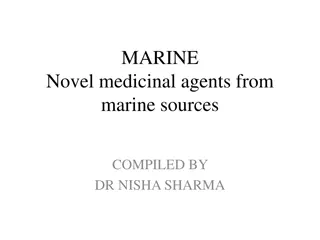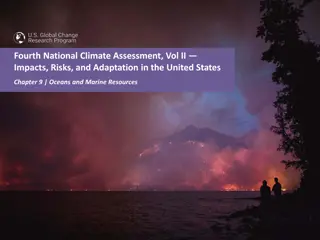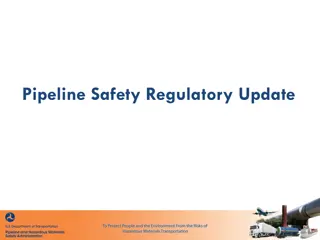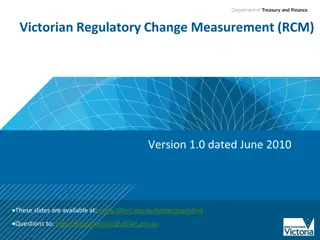Marine Mammal Protection Act (MMPA) Overview and Regulatory Training
Gain insights into the Marine Mammal Protection Act (MMPA) and its regulatory training program. Understand the prohibitions, exceptions, and permits related to fisheries, as well as key terms like harassment and Optimum Sustainable Population (OSP). Explore the significance of Take Reduction Plans and compliance documentation in rulemaking processes.
Download Presentation

Please find below an Image/Link to download the presentation.
The content on the website is provided AS IS for your information and personal use only. It may not be sold, licensed, or shared on other websites without obtaining consent from the author. Download presentation by click this link. If you encounter any issues during the download, it is possible that the publisher has removed the file from their server.
E N D
Presentation Transcript
Welcome CHAPTER 7b: Marine Mammal Protection Act (MMPA) Regulatory Training Program
Objectives Identify how the MMPA take prohibition applies to fisheries Describe the List of Fisheries and how it can be used during the FMP development Explain how MMPA take reduction plans and teams relate to FMP Development Describe how compliance with MMPA is documented in MSA rulemaking
Agenda MMPA Basics and Some Key Terms Defined Take Prohibition Exceptions and MMPA Permits/Authorizations Fishing and the MMPA: the List of Fisheries and Associated MMPA Requirements for Commercial Fisheries Take Reduction Plans, the Role of Take Reduction Teams, and TRP s Relationship to MSA Actions MMPA Determinations in MSA Rulemakings
MMPA Basics Enacted in 1972; amended substantially in 1994 Prohibits the taking of marine mammals, with limited exceptions. Protects all marine mammals regardless of ESA status; additional protection for ESA-listed species Highly protective standards (optimum sustainable population)
Some Key Terms Defined Take: to harass, hunt, capture, or kill any marine mammal or attempt to do so (16 U.S.C. 1362) Harass: any act of pursuit, torment, or annoyance which-- (Level A Harassment) has the potential to injure a marine mammal or marine mammal stock in the wild; or, (Level B Harassment) has the potential to disturb a marine mammal or marine mammal stock in the wild by causing disruption of behavioral patterns, including, but not limited to, migration, breathing, nursing, breeding, feeding, or sheltering but which does not have the potential to injure a marine mammal or marine mammal stock in the wild.
Some Key Terms Defined OSP (Optimum Sustainable Population): With respect to any population stock, the number of animals which will result in the maximum productivity of the population or the species, keeping in mind the carrying capacity of the habitat and health of the ecosystem of which they form a constituent element PBR (Potential Biological Removal): The maximum number of animals (not including natural mortality) that can be removed from a stock while allowing the stock to reach or maintain its OSP PBR = Nmin * 1/2 Rmax * RF Strategic Stock: - A marine mammal stock that is listed under the ESA, declining and likely to be listed within the foreseeable future, or listed as depleted under the MMPA, or for which direct human-caused mortality exceeds PBR
Take Prohibition Exceptions Incidental Take Exceptions Commercial fishing Non-fishing commercial activities (e.g., oil and gas) Direct Take Exceptions Subsistence hunting/handicrafts by AK natives Scientific research, public display, and photography Non-lethal deterrence Pinniped removal authority
MMPA Permits/Authorizations Permits/authorizations are required to conduct activities that may impact marine mammals, whether covered under the ESA (for endangered/threatened) and/or MMPA (all marine mammals) Permits/authorizations applicable to commercial fisheries: MMAP Certificate Section 101(a)(5)(e) (negligible impact determinations for ESA- listed marine mammals) 101(h) (for U.S. purse seine vessels) Section 306 (for U.S vessels and/or operators participating in the International Dolphin Conservation Program)
Fishing and the MMPA: Assessing and Reducing Take Section 117: Stock Assessment Reports (SARs) and Scientific Review Groups (SRGs) Section 118: Taking of marine mammals incidental to commercial fishing operations; zero mortality rate goal Marine Mammal Authorization Program (MMAP) List of Fisheries (LOF) Take Reduction Program
List of Fisheries (LOF) Classify all U.S. commercial fisheries on an annual List of Fisheries according to levels of mortality and serious injury Two-tiered, stock-specific classification approach: Tier 1: Category III if total annual mortality and serious injury across all fisheries that interact with a stock <10% potential biological removal (PBR) Tier 2: Annual incidental mortality and serious injury of a stock in a given fishery is: Category I =Frequent ( > 50% PBR) Category II =Occasional (>1% but <50% PBR) Category III= Remote likelihood or no known (<1% PBR ) LOF Reviewed and revised annually; published in the Federal Register and on the OPR website: http://www.nmfs.noaa.gov/pr/interactions/fisheries/lof.html
MMPA Requirements for Commercial Fishers Category I and II fishers subject to registration, observers (when requested), and any TRP requirements Commercial fishermen in Category I or II fisheries on the List of Fisheries are automatically registered and required by law to carry a Marine Mammal Authorization Certificate when fishing. All fishers (Category I, II, and III) must report any incidental takes within 48 hours of incident or return to port
Take Reduction Plans (TRPs) NOAA Fisheries: Must develop/implement TRPs for strategic stocks that interact with Category I or II fisheries, and May develop/implement TRTs for non- strategic stocks which interact with a Category I fisheries Goals: Short-term goal (within 6 months): mortality & serious injury < PBR; Long-term goal (within 5 years): mortality & serious injury < insignificance threshold (i.e., 10% of PBR), considering: Economics of the fishery Availability of existing technology Existing state/regional fishery management plans
TRP Development and Implementation Consensus recommendations developed by stakeholder- based take reduction teams (TRTs) under rigorous timelines Council reps included on TRTs Plan contents include review of stock assessment information; mortality/serious injury estimates; regulatory and voluntary measures for bycatch reduction; and dates for achieving goals NMFS develops regulations based on Team consensus recommendations NMFS implements, monitors, and evaluates measures set forth within the Plans
Take Reduction Plans and Council Representatives Completed TRPs Atlantic Large Whale (NEFMC, MAFMC, SAFMC) Bottlenose Dolphin (MAFMC, SAFMC) Harbor Porpoise (NEFMC, MAFMC) Pacific Offshore Cetacean (PFMC) Atlantic Pelagic Longline (Atlantic HMS AP) False Killer Whale (WPRFMC) Current TRT Atlantic Trawl Gear (NEFMC, MAFMC)
The Marine Mammal Commission An independent agency of the U.S. Government established by the MMPA to provide oversight of marine mammal conservation programs carried out by federal agencies (e.g., NMFS and U.S. Fish & Wildlife Service) Commission consists of three Commissioners appointed by the President, a nine-member Committee of Scientific Advisors, and 14 employees The Committee of Scientific Advisors and Commission staff work with Commissioners to provide oversight and recommendations Commission staff serve as Take Reduction Team members and attend Scientific Review Group meetings, among other duties
MMPA Relationship to MSA Fishery Management Actions In approving MSA actions, NOAA Fisheries must determine that they are consistent with MMPA requirements, including any fishing restrictions imposed by TRPs. When marine mammals are involved, early and often communication between/at all staff levels is key!
MMPA Determinations in MSA Rulemaking Impacts on MMPA species evaluated and documented in fishery management actions via NEPA process and via other applicable law determination No defined consultation process under the MMPA for federal fishery actions directly comparable to the consultation process/requirements under the ESA or for EFH Examples Package contains specific guidance Reference LOF name and classification and any associated TRPs and regulations and negligible impact determinations (as applicable) in FMP amendments and decision memoranda
Summary Key Points MMPA prohibits take of marine mammals, but provides exceptions for incidental take in commercial fisheries (and a program to authorize and reduce take) SAR, LOF, and TRP publications contain important information relevant to the fishery management process Take reduction planning is a consensus-based, collaborative process to develop take reduction measures, and is the forum for FMCs to engage in marine mammal conservation through their representation on take reduction teams Early and often communication between NMFS Sustainable Fisheries/Protected Resources staff is important to ensure fishery management is complementary to marine mammal conservation under the MMPA
2 1 3 6 4 5 7 8 9






















